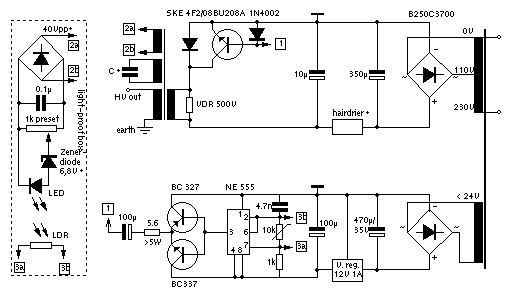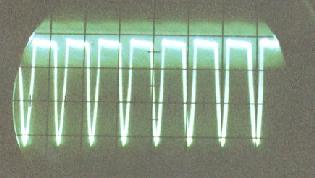


 This is the
circuit diagram of my version together with an oscillosope
screenshot (probed across the primary flyback winding, parallel to the VDR;
200V/div. vertical, 50us/div horizontal). (NOTE: VDR = Voltage Dependent Resistor = MOV = Metal Oxide Varistor!) The hairdrier protects the
BU208A from overload. It makes it possible to virtually short-circuit the
output without the transistor getting too hot. Instead, the heat is
dissipated by the hairdrier. The diode SKE 4F2/08 can be replaced by
any fast-switching diode capable of about 3A/800V. There's also a
version BU208D of the transistor with a diode integrated, but it's
more expensive, and I have't tested it. The best way to find out the
correct terminals of the flyback is to have a circuit diagram of the
TV it comes from; the second best is simply to try every combination
(using a variable transformer to turn up "mains" voltage slowly,
so nothing is damaged). The value of C depends on your flyback and
which winding you use. Use one with about 1000V output and around 1nF
for the cap. The VDR is essential, without it your BU208A will die
with the first spark. But the whole regulation circuit (on
the left) is optional, you have to adjust the frequency by hand anyway.
A more detailed description how it works
and how to adjust it will follow sometime, I hope. Email me if you want to know
more.
This is the
circuit diagram of my version together with an oscillosope
screenshot (probed across the primary flyback winding, parallel to the VDR;
200V/div. vertical, 50us/div horizontal). (NOTE: VDR = Voltage Dependent Resistor = MOV = Metal Oxide Varistor!) The hairdrier protects the
BU208A from overload. It makes it possible to virtually short-circuit the
output without the transistor getting too hot. Instead, the heat is
dissipated by the hairdrier. The diode SKE 4F2/08 can be replaced by
any fast-switching diode capable of about 3A/800V. There's also a
version BU208D of the transistor with a diode integrated, but it's
more expensive, and I have't tested it. The best way to find out the
correct terminals of the flyback is to have a circuit diagram of the
TV it comes from; the second best is simply to try every combination
(using a variable transformer to turn up "mains" voltage slowly,
so nothing is damaged). The value of C depends on your flyback and
which winding you use. Use one with about 1000V output and around 1nF
for the cap. The VDR is essential, without it your BU208A will die
with the first spark. But the whole regulation circuit (on
the left) is optional, you have to adjust the frequency by hand anyway.
A more detailed description how it works
and how to adjust it will follow sometime, I hope. Email me if you want to know
more.
As I said, this device is designed to feed TV cascades, and it does this much more efficiently than the above 5kV mains transformer (due to the higher operating frequency). You can draw a very hot arc from it as well. So if you have the necessary knowledge, it's really worth the labour (and price), especially when used with the 80kV super-cascade .